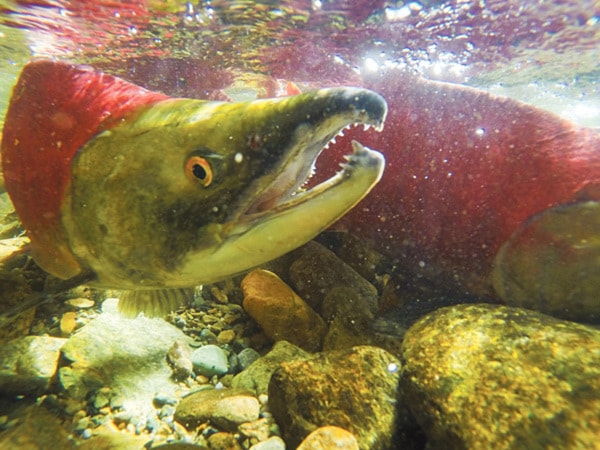Wildly fluctuating estimates of the summer sockeye run seemed to stabilize last week.
As of Friday, Aug. 14, test fishing and DNA evidence used to identify the sockeye’s destination bumped projections up from 1.15 million to 1.5 million.
That may not seem like much, but that’s 350,000 fish – about a 30 per cent increase, notes Stu Cartwright, acting area director of federal Fisheries and Oceans Canada for the B.C. Interior.
He said test fisheries in marine areas since Aug. 14 have shown steady, decent numbers.
“They’re not the numbers that will get us out of the hole and have people doing the happy dance, but we seem to have found a stable area where the run size isn’t going down,” he said, noting estimating returns depends on a number of variables. “We’re not happy; we’d like to see the run back up over the two million range.”
Cartwright says some senior Pacific Salmon Commission members are thinking that, based on information gathered from the test fisheries, the timing of the summer stocks may be as late as two weeks. A test fishery at Johnstone Strait on Aug. 18 indicated between 78 and 81 per cent of the salmon were still summer-run sockeye.
Late-run stocks were only making up 11 per cent of sockeye observed in test runs.
The Shuswap has a number of sockeye groupings, early summers that head to Scotch Creek and the Seymour River, usually from late July to mid August, followed by another group that comes in from early- to mid-August.
The late sockeye run normally begins in late August and continues through September, with the fish heading home to Adams River, Shuswap Lake and Eagle River.
Numbers of late-run sockeye are not expected to amount to much this first year after the 2014 dominant run on the Adams River.
Meanwhile, the first late summer sockeye reached the Scotch Creek fence on Monday, Aug. 17, eight days after the fence was installed.
Fish have been moving through since Monday and some have been observed gathering in big Shuswap Lake off the mouth of Scotch Creek.
Thanks to shorter days and longer nights, water temperatures in the Shuswap were more favourable, having dropped from highs of 18C to a cooler 14 to 16 last week.
But water temperatures remained dangerously high on the Fraser River. On Aug. 20, the temperature just above Hope was 19.6C, fully 1.5C above the average historical 18.1 temperature for the date.
“The forecast for Fraser River temperatures is to go up slightly,” said Cartwright last Thursday, noting warmer water from the Thompson River was raising temperatures in the Fraser below the confluence by close to one degree.
Meanwhile, lower-than-normal water levels are an issue on the Salmon River, where chinook will soon be attempting to find their way to their spawning grounds.
The delta branches out instead of flowing through one channel, says Cartwright. Sand and silt fill in and the fish have an almost impossible task of getting over a resulting berm.
It’s hoped rains will make this easier when the bulk of the chinook run comes through in September.
